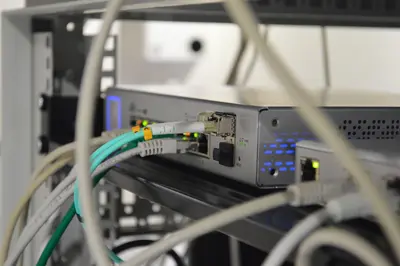🌐 AlmaLinux DNS Server: Complete BIND Setup & Management Guide
Hey there, DNS master! 🎉 Ready to control the internet’s phone book? Today we’re setting up BIND (Berkeley Internet Name Domain) on AlmaLinux – the most widely used DNS server that powers a huge portion of the internet! 🚀
Whether you’re managing domains for your company, creating a local DNS resolver, or learning how the internet really works, this guide will turn your AlmaLinux server into a DNS powerhouse! 💪
🤔 Why is Running a DNS Server Important?
Think of DNS as the internet’s GPS – without it, you’d have to remember IP addresses like 192.168.1.100 instead of domain names! 😱 Your own DNS server gives you complete control over name resolution!
Here’s why BIND on AlmaLinux is essential:
- 🎯 Complete Control - Manage your own domains and records
- ⚡ Faster Resolution - Cache queries for lightning-fast responses
- 🔒 Enhanced Security - DNSSEC support and access controls
- 🌍 Custom Domains - Create any internal domains you want
- 📊 Split-Horizon DNS - Different answers for internal/external queries
- 🛡️ Privacy Protection - No DNS snooping by ISPs
- 💼 Enterprise Features - Load balancing and failover
- 🔄 Dynamic Updates - Automatic record updates
🎯 What You Need
Before we start building your DNS infrastructure, let’s check prerequisites:
✅ AlmaLinux 9.x server (with static IP) ✅ Root or sudo access for configuration ✅ Basic networking knowledge (IPs, subnets) ✅ Domain name (optional, for authoritative setup) ✅ 2+ GB RAM for caching server ✅ Port 53 open (TCP and UDP) ✅ Backup DNS server (recommended) ✅ Coffee ready ☕ (DNS can be tricky!)
📝 Step 1: Install and Configure BIND
Let’s install BIND and set up the basics! 🎯
# Install BIND packages
sudo dnf install -y bind bind-utils
# Backup original configuration
sudo cp /etc/named.conf /etc/named.conf.backup
# Configure BIND main settings
sudo tee /etc/named.conf << 'EOF'
// BIND Configuration File
options {
// Network settings
listen-on port 53 { 127.0.0.1; 192.168.1.0/24; };
listen-on-v6 port 53 { ::1; };
// Directory paths
directory "/var/named";
dump-file "/var/named/data/cache_dump.db";
statistics-file "/var/named/data/named_stats.txt";
memstatistics-file "/var/named/data/named_mem_stats.txt";
// Security settings
allow-query { localhost; 192.168.1.0/24; };
allow-transfer { none; };
recursion yes;
// DNSSEC validation
dnssec-enable yes;
dnssec-validation yes;
// Forwarding (use Google DNS as backup)
forwarders {
8.8.8.8;
8.8.4.4;
};
// Hide version
version "DNS Server";
// Cache settings
max-cache-size 256M;
max-cache-ttl 3600;
};
// Logging configuration
logging {
channel default_log {
file "/var/log/named/default.log" versions 3 size 5m;
severity dynamic;
print-time yes;
print-severity yes;
print-category yes;
};
channel queries_log {
file "/var/log/named/queries.log" versions 3 size 10m;
severity info;
print-time yes;
};
category default { default_log; };
category queries { queries_log; };
};
// Root hints
zone "." IN {
type hint;
file "named.ca";
};
// Include local zones
include "/etc/named.rfc1912.zones";
include "/etc/named.root.key";
include "/etc/named/zones.conf";
EOF
# Create log directory
sudo mkdir -p /var/log/named
sudo chown named:named /var/log/named
# Create zones configuration file
sudo tee /etc/named/zones.conf << 'EOF'
// Forward zone for example.local
zone "example.local" IN {
type master;
file "example.local.zone";
allow-update { none; };
};
// Reverse zone for 192.168.1.0/24
zone "1.168.192.in-addr.arpa" IN {
type master;
file "192.168.1.rev";
allow-update { none; };
};
EOFPerfect! BIND is configured! 🎉
🔧 Step 2: Create DNS Zone Files
Now let’s create zone files for our domains:
# Create forward zone file
sudo tee /var/named/example.local.zone << 'EOF'
$TTL 86400
@ IN SOA ns1.example.local. admin.example.local. (
2024010101 ; Serial
3600 ; Refresh
1800 ; Retry
604800 ; Expire
86400 ; Minimum TTL
)
; Name servers
IN NS ns1.example.local.
IN NS ns2.example.local.
; Name server A records
ns1 IN A 192.168.1.10
ns2 IN A 192.168.1.11
; A records for hosts
@ IN A 192.168.1.10
www IN A 192.168.1.20
mail IN A 192.168.1.25
ftp IN A 192.168.1.30
db IN A 192.168.1.35
; CNAME records
webmail IN CNAME mail
portal IN CNAME www
; MX records
@ IN MX 10 mail.example.local.
; TXT records
@ IN TXT "v=spf1 mx -all"
EOF
# Create reverse zone file
sudo tee /var/named/192.168.1.rev << 'EOF'
$TTL 86400
@ IN SOA ns1.example.local. admin.example.local. (
2024010101 ; Serial
3600 ; Refresh
1800 ; Retry
604800 ; Expire
86400 ; Minimum TTL
)
; Name servers
IN NS ns1.example.local.
IN NS ns2.example.local.
; PTR records
10 IN PTR ns1.example.local.
11 IN PTR ns2.example.local.
20 IN PTR www.example.local.
25 IN PTR mail.example.local.
30 IN PTR ftp.example.local.
35 IN PTR db.example.local.
EOF
# Set permissions
sudo chown root:named /var/named/*.zone
sudo chown root:named /var/named/*.rev
sudo chmod 640 /var/named/*.zone
sudo chmod 640 /var/named/*.rev
# Check configuration
sudo named-checkconf
sudo named-checkzone example.local /var/named/example.local.zone
sudo named-checkzone 1.168.192.in-addr.arpa /var/named/192.168.1.revExcellent! Zone files are created! 🌟
🌟 Step 3: Configure Firewall and Start Service
Let’s open the firewall and start our DNS server:
# Configure firewall
sudo firewall-cmd --permanent --add-service=dns
sudo firewall-cmd --reload
# Enable and start BIND
sudo systemctl enable named
sudo systemctl start named
# Check status
sudo systemctl status named
# Test DNS resolution
dig @localhost example.local
nslookup www.example.local localhost
host mail.example.local localhost
# Test reverse lookup
dig @localhost -x 192.168.1.20✅ Step 4: Advanced DNS Features
Let’s add some advanced features to our DNS server:
# Create DNS management script
cat > /usr/local/bin/dns-manager.sh << 'EOF'
#!/bin/bash
# DNS Management Tool
add_a_record() {
read -p "Domain: " DOMAIN
read -p "Hostname: " HOST
read -p "IP Address: " IP
ZONE_FILE="/var/named/${DOMAIN}.zone"
# Add A record
echo "${HOST} IN A ${IP}" >> $ZONE_FILE
# Increment serial
OLD_SERIAL=$(grep Serial $ZONE_FILE | awk '{print $1}')
NEW_SERIAL=$((OLD_SERIAL + 1))
sed -i "s/$OLD_SERIAL/$NEW_SERIAL/" $ZONE_FILE
# Reload zone
rndc reload $DOMAIN
echo "✅ A record added: ${HOST}.${DOMAIN} -> ${IP}"
}
add_cname() {
read -p "Domain: " DOMAIN
read -p "Alias: " ALIAS
read -p "Target: " TARGET
ZONE_FILE="/var/named/${DOMAIN}.zone"
# Add CNAME
echo "${ALIAS} IN CNAME ${TARGET}" >> $ZONE_FILE
# Reload
rndc reload $DOMAIN
echo "✅ CNAME added: ${ALIAS}.${DOMAIN} -> ${TARGET}"
}
list_zones() {
echo "📋 Configured Zones:"
grep "^zone" /etc/named/zones.conf | awk '{print $2}' | tr -d '"'
}
check_dns() {
read -p "Query: " QUERY
echo "🔍 Checking $QUERY..."
dig @localhost $QUERY +short
}
flush_cache() {
rndc flush
echo "✅ DNS cache flushed"
}
show_stats() {
echo "📊 DNS Statistics:"
rndc stats
cat /var/named/data/named_stats.txt
}
case "$1" in
add-a) add_a_record ;;
add-cname) add_cname ;;
list) list_zones ;;
check) check_dns ;;
flush) flush_cache ;;
stats) show_stats ;;
*) echo "Usage: $0 {add-a|add-cname|list|check|flush|stats}" ;;
esac
EOF
chmod +x /usr/local/bin/dns-manager.sh🎮 Quick Examples
Example 1: Split-Horizon DNS
# Configure different views for internal/external
cat >> /etc/named.conf << 'EOF'
// Internal view
view "internal" {
match-clients { 192.168.1.0/24; localhost; };
zone "company.com" {
type master;
file "company.com.internal";
};
};
// External view
view "external" {
match-clients { any; };
zone "company.com" {
type master;
file "company.com.external";
};
};
EOFExample 2: DNSSEC Configuration
# Generate DNSSEC keys
cd /var/named
dnssec-keygen -a RSASHA256 -b 2048 -n ZONE example.local
dnssec-keygen -a RSASHA256 -b 4096 -n ZONE -f KSK example.local
# Sign zone
dnssec-signzone -A -3 $(head -c 1000 /dev/random | sha1sum | cut -b 1-16) \
-N INCREMENT -o example.local -t example.local.zoneExample 3: Dynamic DNS Updates
# Generate update key
tsig-keygen -a hmac-sha256 update-key
# Allow dynamic updates in zone
cat >> /etc/named/zones.conf << 'EOF'
zone "dynamic.local" {
type master;
file "dynamic.local.zone";
allow-update { key update-key; };
};
EOF
# Update record dynamically
nsupdate -k update-key << EOF
server localhost
zone dynamic.local
update add test.dynamic.local 300 A 192.168.1.100
send
EOF🚨 Fix Common Problems
Problem 1: DNS Not Resolving
# Check if BIND is running
sudo systemctl status named
# Check for errors
sudo journalctl -u named -n 50
# Verify configuration
sudo named-checkconf
sudo named-checkzone example.local /var/named/example.local.zone
# Test with dig
dig @localhost example.localProblem 2: Slow DNS Queries
# Check cache effectiveness
rndc stats
grep "cache hit" /var/named/data/named_stats.txt
# Increase cache size
echo "max-cache-size 512M;" >> /etc/named.conf
# Check forwarders
dig @8.8.8.8 google.comProblem 3: Zone Transfer Issues
# Allow specific servers
echo "allow-transfer { 192.168.1.11; };" >> /etc/named.conf
# Test zone transfer
dig @localhost example.local AXFR📋 Simple Commands Summary
| Command | Purpose |
|---|---|
sudo systemctl status named | Check BIND status |
dig @localhost domain.com | Query DNS server |
nslookup domain.com localhost | Lookup domain |
rndc reload | Reload configuration |
rndc flush | Flush DNS cache |
rndc stats | Show statistics |
named-checkconf | Check configuration |
named-checkzone zone file | Validate zone file |
🏆 What You Learned
Congratulations! You’ve mastered DNS with BIND on AlmaLinux! 🎉
✅ Installed and configured BIND DNS server ✅ Created zone files for forward and reverse lookups ✅ Set up caching for faster resolution ✅ Implemented security features ✅ Built management tools for DNS administration ✅ Learned advanced features like DNSSEC and dynamic updates
🎯 Why This Matters
Running your own DNS server gives you complete control over name resolution! 🌟 You can create custom domains, improve network performance, and enhance security! 🚀
Keep your DNS server updated and monitor it regularly for optimal performance! ⭐🙌




